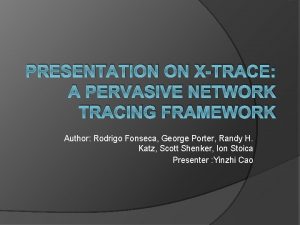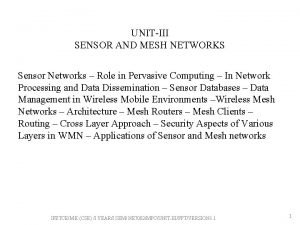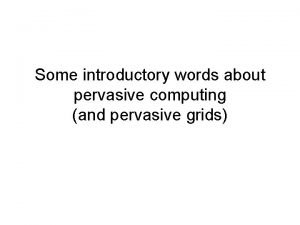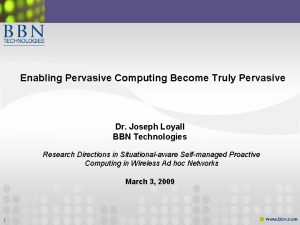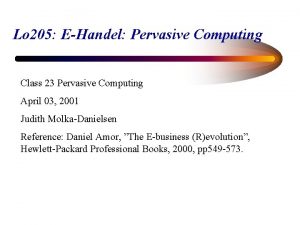Authenticating Pervasive Devices with Human Protocols Ari Juels





![Related Work • Low-Cost Access Control: • [SWE 02], [WSRE 03], [OSK 04] • Related Work • Low-Cost Access Control: • [SWE 02], [WSRE 03], [OSK 04] •](https://slidetodoc.com/presentation_image/547db55006cc4f6dd2d11285ffd4ea13/image-6.jpg)




![Learning Parity with Noise (LPN) • Crypto and learning problems: [BFKL 93] • LPN Learning Parity with Noise (LPN) • Crypto and learning problems: [BFKL 93] • LPN](https://slidetodoc.com/presentation_image/547db55006cc4f6dd2d11285ffd4ea13/image-11.jpg)









- Slides: 20

Authenticating Pervasive Devices with Human Protocols Ari Juels RSA Laboratories Stephen A. Weis MIT CSAIL

Pervasive Devices • Pervasive Devices: ‣ Low memory, few gates ‣ Low power, no clock, little state ‣ Low computational power • Billions of pervasive devices are deployed. • Billions on the way. Can such feeble devices authenticate themselves?

Example Technologies

“Billions and Billions. . . ” • Supply chain management, inventory control • Payment systems, building access • Prescription drug shipments • Retail checkout • Luxury goods • Currency Authenticating devices is a growing concern.

Attacks • Skimming: Reading legitimate tag data to produce fraudulent clones. • Swapping: Steal RFID-tagged products then replace with counterfeit-tagged decoys. • Denial of Service: Seeding a system with fake, but authentic acting tags.
![Related Work LowCost Access Control SWE 02 WSRE 03 OSK 04 Related Work • Low-Cost Access Control: • [SWE 02], [WSRE 03], [OSK 04] •](https://slidetodoc.com/presentation_image/547db55006cc4f6dd2d11285ffd4ea13/image-6.jpg)
Related Work • Low-Cost Access Control: • [SWE 02], [WSRE 03], [OSK 04] • Pervasive Privacy: • [JP 03], [JRS 03], [Avoine 04], [MW 04] • Human Authentication: [HB 01]

Our Contribution • A new authentication protocol that handles active malicious attacks. • Extremely hardware-efficient • Secure under same assumption as [HB 01]

Hopper-Blum Authentication Computer(x) Bob(x, η) a ∈ {0, 1}k Challenge z=(a⋅ x)? z=(a⋅x)⊕ν Response ν ∈R {0, 1} Repeat for q rounds. Authenticate Bob if he passes > (1 -η)q rounds.

Security Against Bad Bob Computer(x) Adversary a ∈ {0, 1}k Challenge z=(a⋅? ) Guess Response

Security Against Passive Eavesdroppers Computer(x) Bob(x, η) Eavesdropper ν ∈R {0, 1} (a 0, z 0), (a 1, z 1), . . . , (aq, zq) Find an x’ that allows you to answer a (1 -η) fraction of a challenges
![Learning Parity with Noise LPN Crypto and learning problems BFKL 93 LPN Learning Parity with Noise (LPN) • Crypto and learning problems: [BFKL 93] • LPN](https://slidetodoc.com/presentation_image/547db55006cc4f6dd2d11285ffd4ea13/image-11.jpg)
Learning Parity with Noise (LPN) • Crypto and learning problems: [BFKL 93] • LPN algorithm: [BKW 03] • Shortest Vector Problem reduction: [Regev 05]

Concrete Security Key Size (k) 64 128 192 224 256 288 Best Attack 235 256 272 280 288 296 Obligatory grain of salt →□

Active Attack against HB Adversary a’ = 000. . . 001 z 0=(a’⋅x)⊕ν 0 Bob(x, η) . . . a’ zn=(a’⋅x)⊕νn Adversary takes majority of zi values to get noise-free parity bit

Our New Protocol: HB+ Reader(x, y) b ∈ {0, 1}k Tag(x, y, η) Blinding Factor a ∈ {0, 1}k Challenge z=(a⋅x)⊕(b⋅y)⊕ν z=(a⋅ x)⊕(b⋅ y)? Response ν ∈R {0, 1}

Security Against Bad Bob Reader(x, y) b’ Malicious Blinding Factor a Challenge z=(a⋅? )⊕(b’⋅? ) Guess Response Adversary

Security against Active Attacks Adversary b Tag(x, y, η) Blinding Factor a’ Malicious Challenge z=(a’⋅x)⊕(b⋅y)⊕ν Response ν ∈ {0, 1}

Detection Security Model Reader Alert ! Adversary Failed Authentications Assume valid readers will detect suspicious failures: No Reader oracles.

Skewing Randomness Adversary • What if the adversary can skew a tag’s random number generator? • All bets are off! Tag

Future Work • Two-round or parallel HB+(Rump Session) • Random Number Generation • Underlying hardness of LPN • Adapting other Human. Auth protocols

Questions? Ari Juels ajuels@rsasecurity. com www. ari-juels. com Stephen Weis sweis@mit. edu crypto. csail. mit. edu/~sweis
 Tero andu'yva
Tero andu'yva X-trace: a pervasive network tracing framework
X-trace: a pervasive network tracing framework Salesforce company overview
Salesforce company overview Specific and pervasive boundaries for behavior
Specific and pervasive boundaries for behavior Pervasive computing wikipedia
Pervasive computing wikipedia Pervasive developmental disorder screening test
Pervasive developmental disorder screening test Pervasive and mobile computing
Pervasive and mobile computing Pervasive computing ppt
Pervasive computing ppt Mobile and pervasive computing
Mobile and pervasive computing Pdd
Pdd Mit mobile wireless
Mit mobile wireless Pervasive mood
Pervasive mood Ari allyn-feuer
Ari allyn-feuer Tekonivelinfektio
Tekonivelinfektio Ari koskelainen
Ari koskelainen Modifikasyon nedir
Modifikasyon nedir Hamk raporttipohja
Hamk raporttipohja Punto y modo articulatorio del fonema r
Punto y modo articulatorio del fonema r Stationary and mobile sources of air pollution
Stationary and mobile sources of air pollution Army ari
Army ari Ari myllyviita
Ari myllyviita

